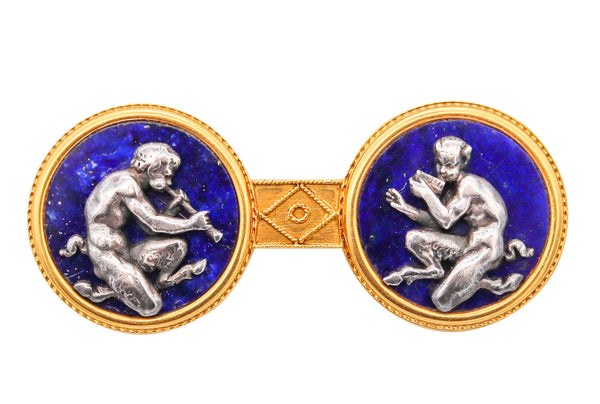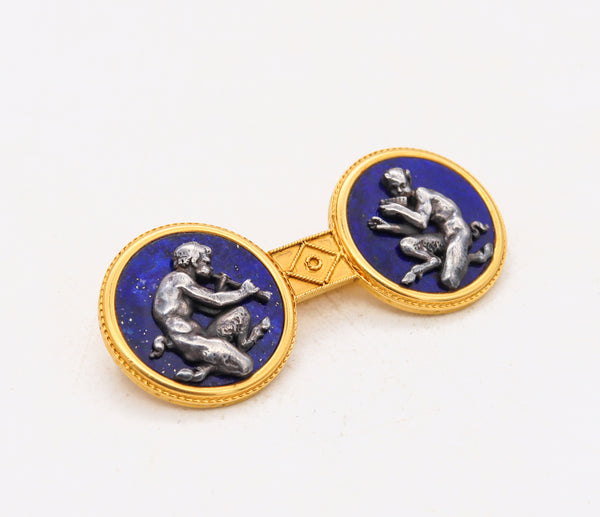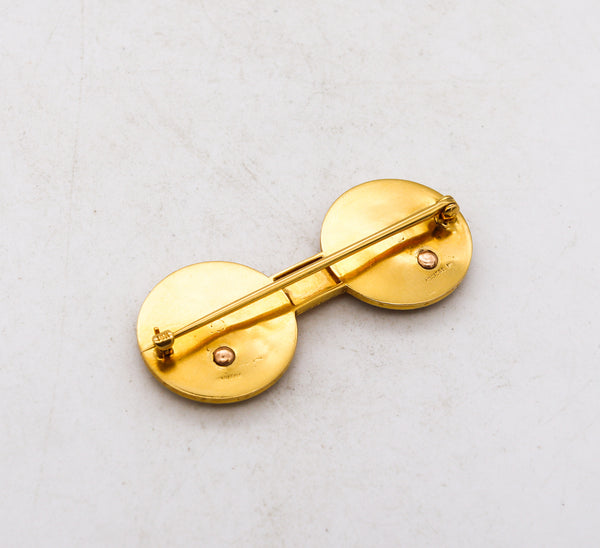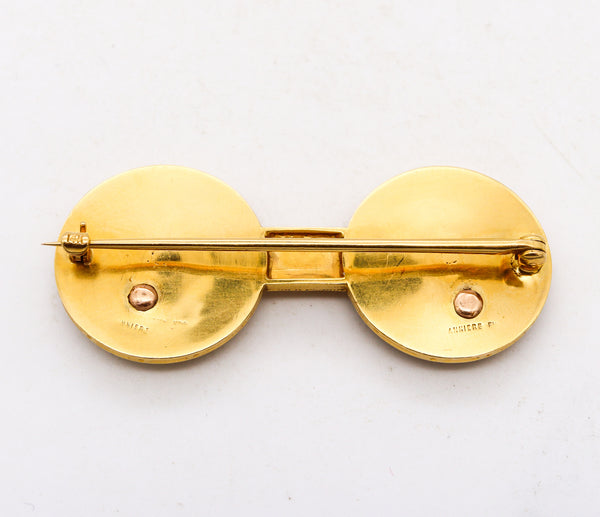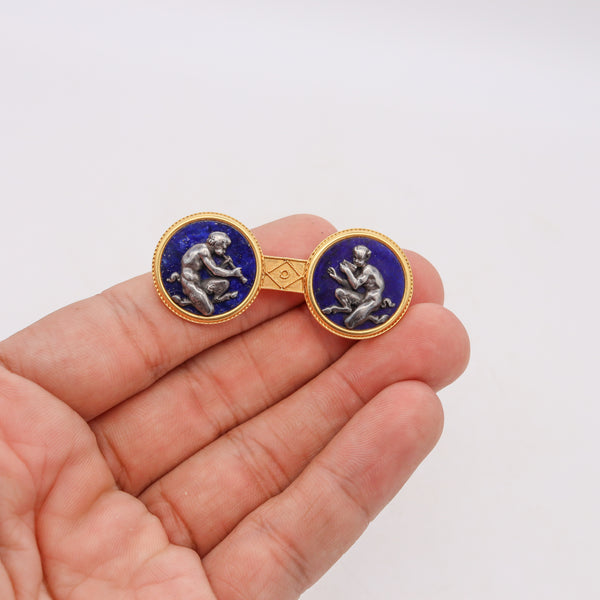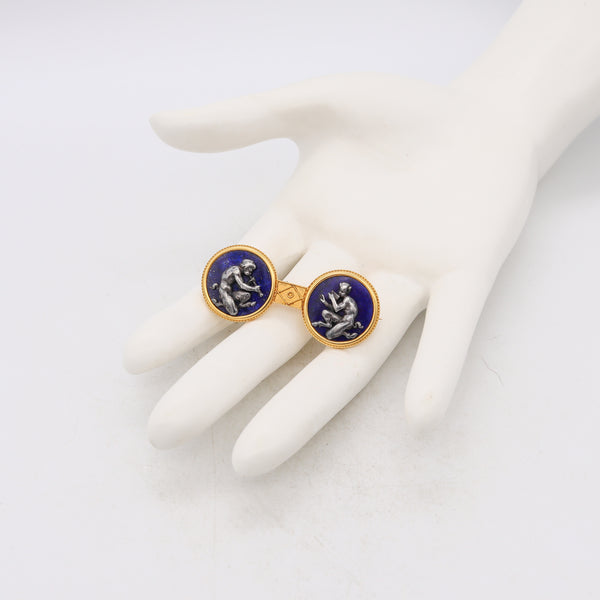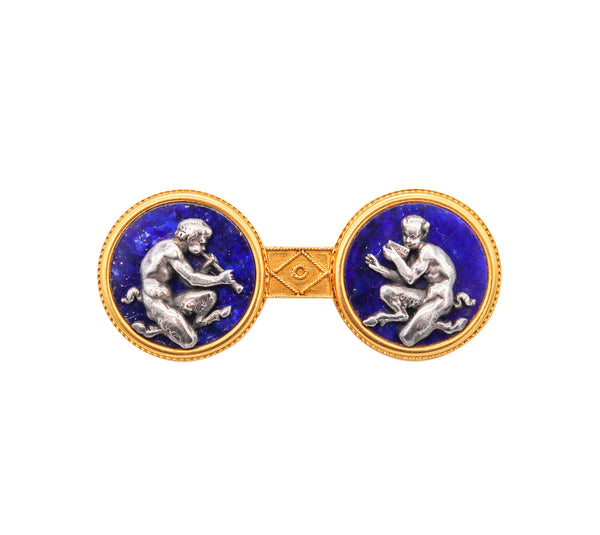Fannière Freres Paris 1880 Rare Etruscan Bacchus Brooch In 18Kt Gold With Carved Lapis Lazuli
Etruscan brooch designed by Fannière Freres.
Very rare and important piece, created in Paris France by the house of Fanniere Freres, back in the 1880. This nice collector's piece has been crafted, with Napoleon III Renaissance-Etruscan Revival patterns in solid yellow gold of 18 karats. It is composed by to rounded elements decorated with the figures of Bacchus playing a flute in one side and the satyr Pan playing an harmonica in the other side.
Embellished, with a pair of carved discs of natural vivid blue Lapis Lazuli.
Has a total weight of 14.4 Grams and a measures of 53 mm by 22 mm (.08 x 0.87 Inches).
Stamped, with the maker's mark and signed, "FANNIERE".
Fannière Frères, was founded in 1839 and led by Auguste (1818-1900) and Joseph (1822-1897), brothers who were trained by their uncle, the celebrated J.H. Fauconnier, silversmith for King Charles X and the royal family. They were draftsmen, sculptors, scissors and manufacturers; they worked for the main Paris’s goldsmiths. Auguste also studied sculpture at the school of fine arts, l'Ecole des Beaux-Arts, in 1838 and exhibited at fairs from 1841 to 1876. The two brothers opened their workshop together, working for the great silver artisans of Paris such as Lebrun, Odiot, Froment-Meurice as well as Christofle.
The house received two first class medals of distinguished merit at the World's Fair of 1855. Determined to exhibit their work under their own names, thereby asserting the technical virtuosity that made their reputation, they were both top-ranked French artists at the London World's Fair of 1862, and awarded a medal. Earning the protection of Emperor Napoleon III with numerous official orders, they achieved great fame, were appointed knights of the Legion of honor (chevaliers de la Légion d'honneur), and earned, at the World's Fair of 1867, the gold medal. Their last appearance at the World's Fair (1900), was highly remarkable. They exhibited a silver beer set, which is now in the Musée d'Orsay. According to Christofle, the Fannière brothers were exceptional because their silver work was made entirely with their own hands, from the composition to the chasing work. His technique of 'viele argent' became used across the continent and he was winner of numerous medals for his jewelry. Victor Hugo even penned a poem about him
Dionysus, (Bacchus for the Romans), was the god of the grape-harvest, winemaking and wine, of fertility, orchards and fruit, vegetation, insanity, ritual madness, religious ecstasy, festivity and theatre in the ancient Greek culture. The iconographic theme on this sheet refer to the legend of the triumph of Dionysus, or as the Romans called him, Bacchus the god of the grape harvest, winemaking and wine, the son of Zeus and Semele. The Bacchanalia was a religious festival in honor of the wine god, Dionysus.
Collateral: It is accompanied by a presentation jewelry box.
Condition: The overall condition of this brooch is excellent. Beside the little normal wear, there is no damage to the gold. All the gemstones, are secured in the settings. This piece has been carefully inspected to guarantee the condition and authenticity.
INVENTORY REF: P0000MONN/.3461








